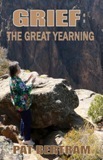Pat Bertram's Blog, page 228
July 16, 2013
Excerpt From “Grief: The Great Yearning” — Day 112
 I never actually set out to write a book about grief, never planned to make any of my writing public (except for the blog posts, of course), but I was so lost, so lonely, so sick with grief and bewildered by all I was experiencing, that the only way I could try to make sense of it all was to put my feelings into words. Whether I was writing letters to Jeff (my deceased life mate/soul mate) or simply pouring out my feelings in a journal, it helped me feel close to him, as if, once again, I was talking things over with him. The only problem was, I only heard my side of the story. He never told me how he felt about his dying and our separation. Did he feel as broken as I did? Did he feel amputated? Or was he simply glad to be shucked of his body, and perhaps even of me?
I never actually set out to write a book about grief, never planned to make any of my writing public (except for the blog posts, of course), but I was so lost, so lonely, so sick with grief and bewildered by all I was experiencing, that the only way I could try to make sense of it all was to put my feelings into words. Whether I was writing letters to Jeff (my deceased life mate/soul mate) or simply pouring out my feelings in a journal, it helped me feel close to him, as if, once again, I was talking things over with him. The only problem was, I only heard my side of the story. He never told me how he felt about his dying and our separation. Did he feel as broken as I did? Did he feel amputated? Or was he simply glad to be shucked of his body, and perhaps even of me?
It’s been three years now since the following piece was written. The wound where he was amputated from me has healed. I don’t worry about him — at least not much — but I still miss him, still feel as if I’m waiting for my life to begin. And though I don’t feel as scattered, I understand more than ever that wherever I am, there I am.
Excerpt from Grief: The Great Yearning
Day 112, Grief Journal
I’m going through a numb phase right now. I only cried briefly yesterday. That came after I finished watching the Paul Hogan/Michael Caton movie Jeff taped—Strange Bedfellows—and I realized I’d never watch movies with him again.
Cry, not cry. Feel, not feel. It’s all the same. Just different aspects of grief. One thing they’re right about. This is WORK! I’m tired, have little energy, don’t seem to be able to think or to do anything but the most basic chores. And I can’t make myself believe anything is important. I’m still waiting to get a grip on my grief. Still feeling as if I’m in a transitional stage, waiting for my life to start.
Except that I had a life. We had a life.
People talk about “healing” when it comes to surviving a death, and it’s as good a term as any. It does seem as if the wound where Jeff was amputated from me is still bloody and gaping, though it is “healing” somewhat. It’s not as constantly raw as it was at first.
I always felt scattered when we were apart, worried about something happening to one of us when the other wasn’t there. Well, something did happen. And I was there. Now it’s just me. Wherever I am, there I am, but I still feel scattered. Fragmented. As if parts of me are strewn all over the universe. There’s no reason to worry about him, but I still do.
Click here to find out more about Grief: The Great Yearning
***
Pat Bertram is the author of the suspense novels Light Bringer, More Deaths Than One, A Spark of Heavenly Fire, and Daughter Am I. Bertram is also the author of Grief: The Great Yearning, “an exquisite book, wrenching to read, and at the same time full of profound truths.” Connect with Pat on Google+. Like Pat on Facebook.
Tagged: 112th day of grief, bereft, grief and healing, grief and searching for meaning, grief as amputation, grief work, Grief: The Great Yearning


July 15, 2013
Move It Or Lose It! Back Up Your Files
In a recent post on the Second Wind Publishing blog, Move it or Lose it –by Sheila Englehart, Sheila talks about the importance of backing up files. Sheila Englehart’s paranormal novel Warning Signs was recently published by Second Wind Publishing, but some of her earlier works can never be published. As Sheila says:
 Right now. Be honest. Exactly where are your treasured works saved? Desk drawer? Pen holder? Coffee mug? Decorative wooden box? External hard drive on the desk next to your computer?
Right now. Be honest. Exactly where are your treasured works saved? Desk drawer? Pen holder? Coffee mug? Decorative wooden box? External hard drive on the desk next to your computer?
I know that you’ve read many articles about the importance of back-ups and where to store them, but did you take action?
A storm just ripped through my neighborhood. Trees tore through power lines, blocked roads, and demolished homes. As I watched the 80 foot trees behind my house part like blades of grass, my first thought wasn’t getting to the basement for safety. No.
Is my backup in the safe? If a tornado takes my house, where would the safe land? … Continue reading →
***
Now that you’re back after reading Sheila’s article (if you cheated and didn’t read her article, please go read it) . . .
I do back up my files, but I’m not as careful as I should be. The disks and external drive are within a couple of feet of my computer, though I do send files from time to time to myself as attachments on emails. (That reminds me, I haven’t sent the most current version of my WIP to myself in a while. I’ll go do that right now.)
I have a partial manuscipt of another book I started a few years ago, but that is still on paper. I’d better type it up one of these days. Soon.
I hope you will take heed and back up your treasured works.
***
Pat Bertram is the author of the suspense novels Light Bringer, More Deaths Than One, A Spark of Heavenly Fire, and Daughter Am I. Bertram is also the author of Grief: The Great Yearning, “an exquisite book, wrenching to read, and at the same time full of profound truths.” Follow Pat on Google+. Like Pat on Facebook.
Tagged: backups, lost works, protecting intellectual property, Sheila Englehart


July 14, 2013
Rubicon Ranch: Secrets — My Newest Chapter
 Rubicon Ranch is a collaborative and innovative crime series set in the fictional desert community of Rubicon Ranch and is being written online by the authors of Second Wind Publishing.
Rubicon Ranch is a collaborative and innovative crime series set in the fictional desert community of Rubicon Ranch and is being written online by the authors of Second Wind Publishing.
In the current story, the body of a local realtor is found beneath the wheels of an inflatable figure of a Santa on a motorcycle. The realtor took great delight in ferreting out secrets, and everyone in this upscale housing development is hiding something. Could she have discovered a secret someone would kill to protect? There will be suspects galore, including a psychic, a con man, a woman trying to set up an online call-girl service, and the philandering sheriff himself. Not only is the victim someone he had an affair with, but he will also have to contend with an ex-wife who has moved back in with him and a jilted lover, both with their own reasons for wanting the realtor dead.
We hope you will enjoy seeing the story develop as we write it. Let the mystery begin! Whodunit? No one knows, not even the writers, and we won’t know until the very end! If you don’t want to miss further chapters, please go to the blog and click on “sign me up” on the right sidebar to get notifications of new chapters.
(If the Christmas theme seems unseasonal, well . . . considering how long it takes to write a book at the rate of a chapter a week, in a few months, the season will catch up to us!)
Chapter 15: Lydia Gavin
by Pat Bertram
Sunday, December 23, 2:20pm
Lydia sat by Zazzi’s pool, soaking up what rays she could. She had helped Zazzi open the umbrella over the patio table, but since it was too cold to sit in the shade, she’d moved a chair out into the sunlight.
Sun.
Fire.
Lydia stared up at the pale blue winter sky and shivered with delight at the thought of that burning ball overhead. Did the Goddess love fire as much as she did? Is that why she had created so many suns?
Lydia smiled, remembering the flames curling around the hideous living room furniture. She had lied to Zazzi about not being in the house when the fire had started, but she saw no reason to tell the truth. Zazzi sure as hell wasn’t being honest with her. Lydia might not be a cop any more, but she still had her cop’s nose, and that nose told her whatever business Zazzi operated didn’t bear scrutiny. Still, the woman had made her welcome and offered her a room for the night, which made Lydia think kindly of her. And anyway, Lydia had to admit her own life no longer could hold up under a close examination.
With Nancy and her prying eyes and magpie mentality out of the way, though, she was safe, at least for a while.
How much had Nancy known? In her mind, Lydia went over every detail of her husband’s death, and couldn’t see where she had slipped up. No one knew of her husband’s abuse, not even Seth. When she and Seth were naked together, she’d kept the lights dimmed so any welts and bruises wouldn’t show, and if he’d inadvertently aggravated the injuries, he’d mistaken her groans of pain as moans of pleasure.
She’d vowed that the beating her husband gave her for having the affair would be the last time he’d ever hurt her. Things were okay at first after she got kicked off the job—he’d liked the idea of a slave wife—but then came the day he’d lost a big case. He’d blamed her, of course, saying that she’d never be a proper lawyer’s wife. He’d raised a hand to her. She dashed away. He caught her at the top of the stairs. She pushed. He fell down the marble steps. Cracked his head. She stared at him for a moment, wondering if she should call an ambulance—he’d probably be okay with immediate care. Instead, she sneaked out the back door, went for a run, and left him to die.
Dozens of people had seen her jogging in her fuchsia shorts and lime green top, and though she’d been questioned, the cops never suspected her. Why should they? She had an alibi and she’d always played the loving wife in public.
But Nancy had found out. Or had she? When the realtor said in that oh, so ominous voice, “I know you killed your husband,” could she have been merely fishing?
It didn’t matter now. Nothing mattered but those lovely dancing flames. Even Seth’s love had never ignited her the way the heat of the fire had.
As she’d watched the flames devour the furniture, the stone Lydia had seemed to melt and flow like lava, and suddenly she’d been awash in a volcano of molten tears. She’d never known such life. Love. Ecstasy.
She’d managed to wrest herself away from the flames and rush outside before her new love could hurt her as much as her past loves, and although she wanted to continue her enthrallment with the blaze, she couldn’t bear to be around the gawkers. What could they know of the love that now burned in her heart? Only the paltry excitement of destruction kept them riveted to the scene.
Lydia had wandered off in a daze, and hadn’t come back to herself until Zazzi had confronted her. She’d managed to hide her rapture behind cop’s eye—that cold calculating look was not something you ever forgot how to give—keeping her secret safe in her heart.
Lydia stared up at the sun, and took a deep breath. The air smelled deliciously of smoke and ashes and charcoal and burnt offerings. Is this what the Goddess smelled every day of creation? Lydia stretched, like a cat on a warm hearth, and wondered where to go from here.
Home, probably. She could no longer remember why she’d come to Rubicon Ranch. Had she come just to be near Seth? To try to get back together with him? To get even? To remove her competition? To warn his new love of his philandering ways?
It hadn’t been hard to find out about his affair with Nancy. She’d simply followed him one day when he left the sheriff’s department and seen him meet with the realtor. She’d only made an appointment with Nancy to see what Seth preferred over her, but had stayed to watch the fun when she realized Seth had met his match.
Were all men so blind they couldn’t see what was in front of their very eyes? She had deeply loved Seth, wanting only the best for him, and he had thrown her away, calling her a vituperative bitch. Yet Nancy, who didn’t love him, and who truly was a vituperative bitch, he had kept.
But now she was through with men and their incomprehensible needs. She had found something better. Something that would never let her down. Something that would forever burn in her heart.
Fire!
***
Pat Bertram is the author of the suspense novels Light Bringer, More Deaths Than One, A Spark of Heavenly Fire, and Daughter Am I. Bertram is also the author of Grief: The Great Yearning, “an exquisite book, wrenching to read, and at the same time full of profound truths.” All Bertram’s books are published by Second Wind Publishing. Connect with Pat on Google+
Tagged: mystery series collaboration, online novel, Rubicon Ranch, Rubicon Ranch Necropieces, Rubicon Ranch: Secrets, Second Wind Publishing


Saying Happy Birthday to the Dead
Today is the birthday of my life mate/soul mate. I suppose I should say “was” the birthday — he’s been dead for more than three years. We never celebrated our birthdays, and for some reason, that seems sad to me now. I never told him “Happy birthday,” never made him a birthday cake, never gave him a birthday present.
He didn’t believe in continued life after death, and yet, when I went through his “effects” a couple months after he died, I found a quote he had saved: “Life is rather a state of embryo — a preparation for life. A man is not completely born until he has passed through death.”
 Did he believe those words? Did he want to believe them? Or was the quote something that caught his attention once upon a time, and he kept it whether he believed it or not? Still, I wonder — if he continues to exist somewhere, does he celebrate his death day as his birthday? Or does he still not believe in celebrating such rites of passage?
Did he believe those words? Did he want to believe them? Or was the quote something that caught his attention once upon a time, and he kept it whether he believed it or not? Still, I wonder — if he continues to exist somewhere, does he celebrate his death day as his birthday? Or does he still not believe in celebrating such rites of passage?
We were alike in our disinterest in such celebrations, but ever since he died, I’ve been making a point of celebrating life’s moments. So today I got the birthday cake I never got for him while he was alive. (And hey, if he doesn’t want any, then there’s more for me!) I will watch one of the movies he taped and remember when he used to sit by my side and watch with me. I will think of him, not as he would be today, 67 years old, or even as he was at the end, but as he was when we met — young, radiant, and be-coming.
I will give thanks that he shared his life with me.
And I will say those words I never spoke before, “Happy birthday, Jeff.”
***
Pat Bertram is the author of the suspense novels Light Bringer, More Deaths Than One, A Spark of Heavenly Fire, and Daughter Am I. Bertram is also the author of Grief: The Great Yearning, “an exquisite book, wrenching to read, and at the same time full of profound truths.” Follow Pat on Google+. Like Pat on Facebook.
Tagged: birthdays and death, birthdays and grief, life is a state of embryo


July 13, 2013
A Life Full of Possibilities
Connections make life worth living, but more than that, connections make life itself.
At the most quantum level, possibilities connect and become waves. Waves connect and become particles. Particles connect and become atoms. Atoms connect and become molecules. Molecules connect and become cells. Cells connect and become gametes. Gametes connect and become us. We connect and become communities. Communities connect and become countries.
A matrix of connections in our brains makes thinking possible. An entire matrix of connections hold s us to the earth and makes living possible.
s us to the earth and makes living possible.
Despite these long strings of connections, I’m beginning to see that disconnections are almost as important as connections. When my life mate/soul mate died a little more than three years ago, the connective tissue of my life disintegrated, and my world lay in a heap of rubble at my feet.
Since then, more connections have disintegrated, adding to that heap of rubble. Some of those disconnections were interpersonal ones — friends and family. Other disconnections were intrapersonal ones — thoughts, hopes, even my very identity.
Often during these past years, I have despaired at the thought that only bleakness lay ahead of me. But bleakness is but one possibility. Within that pile of rubbish lie many new possibilities. Perhaps I am one of the lucky ones, getting to start all over with a new set of possibilities. As people have been telling me for the past three years, life is such a big place with endless possibilities I have never dreamed of. They have told me the universe is unfolding as it should, and that it is not yet finished working in my life. They have told me that wonderful things lie ahead of me.
What of that is true, I don’t know, but what I do know is that no matter what fate has in store for me, I am not yet finished working in my life. Just as I am gradually sorting through the detritus of my shared life, getting rid of things for which I no longer have any practical or emotional need, I am sorting through the rubble of my shattered world. Maybe I will find enough shards to rebuild my life into something workable, or maybe I will have to go out and look for pieces I can use to rebuild my life into something special.
Since my current responsibilities keep me from actually going out in the world and physically searching for new connections, I am starting with me, rethinking old beliefs, trying on new thoughts, discarding old hopes, and dreaming new possibilities into reality.
Because, at its most basic level, life is nothing but possibilities.
***
Pat Bertram is the author of the suspense novels Light Bringer, More Deaths Than One, A Spark of Heavenly Fire, and Daughter Am I. Bertram is also the author of Grief: The Great Yearning, “an exquisite book, wrenching to read, and at the same time full of profound truths.” Follow Pat on Google+. Like Pat on Facebook.
Tagged: connections, connections and disconnections, creating new possibilities, quantum level of life, unfolding universe, world of possiblities


July 12, 2013
To Whom Do We Owe Loyalty?
In this age of consumerism, loyalty seems such an old-fashioned quality when used in reference to people. There is more talk of “brand loyalty” than there is of loyalty as a virtue. To be honest, I’m not sure loyalty is a virtue — it seems more of character trait than something to which one aspires.
Still, I’ve always been intensely loyal, especially to those I love, but also to other things. For example, while managing a fabric store once upon a time, I never shopped for fabric at any other franchise. Well, I did once, but never again. I felt as if I were being disloyal to my employer.
For most of my life, I thought love and loyalty were different facets of the same state, and if someone said they loved me, I assumed they would also be loyal, but now I know love and loyalty are two different things. Love is a deep feeling of affection and caring (and sometimes desire) for another person. Loyalty is a sense of allegiance, commitment, and dedication.
Loyalty, more than love, is what makes two people a couple. Loyalty keeps the two parties together, keeps them focused on a common goal, keeps them allied. I was intensely loyal to my life mate/soul mate, so much so that when he died, I wasn’t sure if I had the right to be happy here on Earth. Even the idea of someday being happy seemed disloyal, as if it were negating our life together.
I’m dealing with another situation now that makes me question the concept of loyalty itself. In this case, m y loyalties are divided between two family members, and for a while, it was tearing me apart. I can’t ally myself with either party since the two will never agree, never manage to find a way to deal with each other, never even accept the other’s foibles (which, incidentally, are identical, though to varying degrees). Both expect my loyalty and resent my loyalty to the other, but neither has any real loyalty to me.
y loyalties are divided between two family members, and for a while, it was tearing me apart. I can’t ally myself with either party since the two will never agree, never manage to find a way to deal with each other, never even accept the other’s foibles (which, incidentally, are identical, though to varying degrees). Both expect my loyalty and resent my loyalty to the other, but neither has any real loyalty to me.
These matters made wonder to whom I owed loyalty, and I’ve realized that it’s time to transfer my loyalties to myself. There is no way I can takes sides in this current situation, nor can I help in any way, so the best thing for me to do is to do the best thing for me — if I ever figure out what that is.
It’s the same with my deceased mate. Although I will always love him, I can no longer have any loyalties to him. He is not here to be loyal to me, and loyalty, even more than love, needs reciprocation if it isn’t to become a sort of servitude. After more than three years, I now know I have the right to be happy, and if happiness happens to come my way, I have an obligation to grab hold and run with it. Anything else is bondage to a past that is getting further away every day.
***
Pat Bertram is the author of the suspense novels Light Bringer, More Deaths Than One, A Spark of Heavenly Fire, and Daughter Am I. Bertram is also the author of Grief: The Great Yearning, “an exquisite book, wrenching to read, and at the same time full of profound truths.” Follow Pat on Google+. Like Pat on Facebook.
Tagged: is loyalty a virtue, love and loyalty, loyal to the dead, loyalty and betrayal, loyalty vs. servitude, owing loyalty


July 11, 2013
Living on the Edge
Some of my happiest times during the past few years have been when I have been standing on the edge of places.
On the edge of a canyon:
On the edge of a lighthouse:
On the edge of a pier:
On the edge of the continent:
On the edge of a day:
I’m not sure why edges have such appeal for me. Perhaps it’s because when I am on an edge, I can see a long way, catching glimpses of possibilities far in advance of their appearance. Or perhaps it’s because edges create a boundary between two very different areas — land and sea; balcony and air, cliffs and gorges, night and day — and such differences mirror my own internal boundaries. Or perhaps it’s more symbolic, a precursor to the time when I will be standing on the edge of life, looking out onto . . . who knows what.
Some people “collect” lighthouses, going from one to another, taking pictures, maybe even getting stamps in a lighthouse passport. I considered making such a trek someday, but what I’d really like to do is visit edges of places.
Maybe that’s where I’ll finally find happiness: living on the edge.
***
Pat Bertram is the author of the suspense novels Light Bringer, More Deaths Than One, A Spark of Heavenly Fire, and Daughter Am I. Bertram is also the author of Grief: The Great Yearning, “an exquisite book, wrenching to read, and at the same time full of profound truths.” Follow Pat on Google+. Like Pat on Facebook.
Tagged: Black Canyon, edge of the continent, living on the edge, pier, St. Simons Island Lighthouse, sunrise, Ventura Pier


July 10, 2013
Whose Story are You Writing?
Every story is someone’s story. Whether we are writing about war, child abuse, romance, murder, or any other topic, we must make readers care about a character. Readers want someone to root for, to bond with, to love. Once they have found that, they will be eager to read further.
Sometimes it’s hard for us writers to decide whose story we are writing. We create a lot of characters while writing our novels, and we fall in love with all of them, even the villains. We feel disloyal to our creations if we give one character more consideration than others, and we believe the story needs all those points of view. But the reader knows only what is on the page, not what is in our minds, and all those equally significant characters become confusing. Readers need to know whose story it is. Or whose story it mostly is.
One way for us to decide this is to figure out which character has the most at stake and which one will change the most. If we are  lucky, the two will be the same, and we will know whose story it is. If not, we have to make the character who will change the most into the main story character while upping that character’s stakes.
lucky, the two will be the same, and we will know whose story it is. If not, we have to make the character who will change the most into the main story character while upping that character’s stakes.
A character with nothing to lose is not one people will care about. If someone in the story parachutes out of a plane for fun, readers might find it entertaining, but they won’t be concerned. But if someone wearing a faulty parachute jumps out of a plane into flames to save a child lost in the middle of a forest fire, everyone except the most curmudgeonly will care.
The same is true of character growth. A character who remains static, who learns nothing from experience, is not someone readers can love. A story is always about change, and since a story is also about a character, that character must grow, or should at least change in some small way. A timid character might learn to stand up for himself. An arrogant character might learn a touch of humility. The essence of the character does not need to change. A timid reporter who turns into superman is the stuff of comic books, not a realistic novel. But a character who grows, who learns, who comes back from his or her experiences with something to share, that is a character readers care about.
And that’s whose story it is.
***
Pat Bertram is the author of the suspense novels Light Bringer, More Deaths Than One, A Spark of Heavenly Fire, and Daughter Am I. Bertram is also the author of Grief: The Great Yearning, “an exquisite book, wrenching to read, and at the same time full of profound truths.” Follow Pat on Google+. Like Pat on Facebook.
Tagged: a character to root for, character development, creating a sympathetic character, how to tell who the hero is, story, whose story is it


July 9, 2013
How to Hook a Reader
The age of writing long descriptive passages (or even short ones) at the beginning of a novel has passed. Today people want to be drawn immediately into the story without wading through such excess. An editor might look at the first five pages before tossing aside your manuscript, but potential customers will give you a mere twenty seconds to draw them in. Once you have caught their attention, they might read a little further, and perhaps they will even buy the book. They certainly will not wade through five, ten, fifty pages until they get to “the good part.”
That “good part” must be right up front, especially if you’re a first-time writer. That’s all you have going for you — the ability to get off to a fast start and capture the reader’s attention. Your name certainly won’t do it; no one knows who you are yet. Your credentials might help, but only to establish your credibility after a potential reader has been hooked. And they will never be hooked by your ability to turn a clever phrase.
So what will hook the reader? A character. Always a character. No one reads a book for a description of the weather, a place, or an issue. They don’t even want a desc ription of the character. They want to meet him, to see life through his eyes, to bond with him. They want to know what he wants, what his driving force is. And they want to know who or what he’s in conflict with.
ription of the character. They want to meet him, to see life through his eyes, to bond with him. They want to know what he wants, what his driving force is. And they want to know who or what he’s in conflict with.
Without conflict, there is no story, but without a character for the reader to care about, there is no story either. Character and conflict are inextricably combined, and together they create the tension necessary to sustain a story. I know you think it’s okay to let the tension rise slowly, which it is, but the tension level at the beginning must be high enough to let the reader know something is going on.
I rewrote More Deaths Than One four times, and each time, the story fell flat. It wasn’t until I realized I’d spent too much time describing things or had Bob alone meandering through much of the story that the book took on life. I gave Bob a love interest, a server he met at a coffee shop.
More Deaths Than One begins:
“What do you think of a guy who embezzles from his own business?”
Bob Stark recognized the voice of the graveyard shift waitress, the attractive one with the black hair. He glanced up from his contemplation of the scars on the laminated plastic table and saw her standing by his booth, gazing at him, her eyebrows quirked. She seemed to expect a response, but he had no idea what to say.
This isn’t the real hook, it’s just enough to capture your attention so I can reel you in for the punchline.
Reviewer Sheila Deeth said, The first three pages of “More Deaths than One” have to constitute a serious contender for the best opening scene of a novel. Two main characters are introduced, a garrulous waitress and a taciturn hot-chocolate customer. They meet. She talks, a lot. He reads the paper. “And Lydia Loretta Stark was dead. Again.” With two such immediately real and appealing characters, and a line like that, I’d challenge anyone not to want to keep turning the pages.
***
Pat Bertram is the author of the suspense novels Light Bringer, More Deaths Than One, A Spark of Heavenly Fire, and Daughter Am I. Bertram is also the author of Grief: The Great Yearning, “an exquisite book, wrenching to read, and at the same time full of profound truths.” Follow Pat on Google+. Like Pat on Facebook.
Tagged: beginning, character, conflict, hook, hooking a reader, More Deaths Than One, tension


July 8, 2013
How Much of the Truth do We Owe to Others?
Today someone told me I was evil. It wasn’t a joke — the person meant it — and I had no response to that.
Being called an evil woman sounds much more romantic than what I am — someone who’s doing the best she can in a world gone awry. I admit my efforts sometimes fall flat and I make a given situation worse rather than better, especially when my loyalties are divided. But that’s not being evil. That’s being human.
I don’t believe I’m evil, but the reason I couldn’t find a response to the accusation is that it made me wonder: If I am evil, would I know?
Think of all the wars begun in the name of God. Think of all the prejudice fomented by religious folk who adhered too closely to the dictates of the Old Testament. Think of all the pregnant teenagers thrown out into the snow by self-righteous parents. Think of all the people who have harmed others in the name of doing the “right” thing. Did any of these people believe they were evil? Of course not. I’m sure the devil wouldn’t even consider himself (or herself) evil. Like all villains, he/she is the hero of his/her own story. In his/her mind, he/she is the true force of the universe, while God is the evil one.
 This person who believes I am evil based the assessment of me partly on lies I supposedly told, though I have no idea what those lies are. They can’t mean much in the big scheme of things, because I never lie for malicious purposes, though I do occasionally lie to protect me or someone else. And anyway, how much of the truth do we owe others? For example, if someone asks our weight, do we owe him/her the truth? If the person asking is a doctor or a health insurance company, of course, we owe them the truth, just as they owe us the truth about our medical condition, but otherwise divulging information about our weight is not a requirement. Offering a lie, perhaps giving a weight we are comfortable acknowledging, is usually more tactful and much easier than a direct refusal to answer.
This person who believes I am evil based the assessment of me partly on lies I supposedly told, though I have no idea what those lies are. They can’t mean much in the big scheme of things, because I never lie for malicious purposes, though I do occasionally lie to protect me or someone else. And anyway, how much of the truth do we owe others? For example, if someone asks our weight, do we owe him/her the truth? If the person asking is a doctor or a health insurance company, of course, we owe them the truth, just as they owe us the truth about our medical condition, but otherwise divulging information about our weight is not a requirement. Offering a lie, perhaps giving a weight we are comfortable acknowledging, is usually more tactful and much easier than a direct refusal to answer.
We often lie without thinking about it, such as exaggerating our accomplishments a bit so that we come across both to ourselves and to others as being better than we are, but so often these lies are nothing more than hopes verbalized. Sometimes we downplay our accomplishments in the name of modesty. And sometimes we “fudge” the truth, not telling the truth, but not telling a direct lie, either, though the result is the same — a deception.
When it comes to friendship and other relationships, we do owe a certain amount of truth, especially the truth of who we are, but we don’t owe that truth to strangers or to those who don’t have our best interests at heart. In a perfect world, perhaps, we could tell everyone the truth, but in our particular world, divulging too much about ourselves is risky. And it’s especially risky when the person who is asking for our truth is not willing to give up any of his or her truth.
And then there are those who tell us the truth, or at least the truth as they see it, for only one reason, to cause pain.
Which brings me back to my evilness and the lies I supposedly told. I wish I could apologize for these unknown lies and whatever else led to this belief that I am evil, but it is impossible to talk to someone who will not listen. So I’m doing what I always do, dumping my worries and my wonderings onto this blog.
***
Pat Bertram is the author of the suspense novels Light Bringer, More Deaths Than One, A Spark of Heavenly Fire, andDaughter Am I. Bertram is also the author of Grief: The Great Yearning, “an exquisite book, wrenching to read, and at the same time full of profound truths.” Follow Pat on Google+. Like Pat on Facebook.
Tagged: does the devil think he's evil, evil woman, lies, owing the truth, villain as hero










